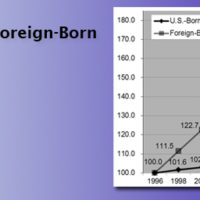New NPG Paper Shows Negative Economic Impact of U.S. Immigration
- NPG
- March 8, 2016
- Press Releases
- 0 Comments
New NPG Paper Shows Negative Economic Impact of U.S. Immigration
Expert analysis reveals the “biggest losers” of mass immigration are America’s poor and middle class.
View this release on PRWeb
This press release was picked up by hundreds of news outlets across the country, including The Star Tribune, The Boston Globe, The Miami Herald, and The Sun News. Together, NPG’s message was distributed to a prospective audience of nearly 226 million Americans.
Click here for a downloadable, printable PDF version.
Alexandria, VA (March 8, 2016) – A January 15th report titled “Do Mature Economies Grow Exponentially?” – authored by German economists Steffan Lange, Peter Pütz, and Thomas Kopp – notes: “Our findings cast doubts on the widespread belief of exponential growth….” In fact, the new report concludes that the frequent assumption by economists and international governments that “economic growth must always be exponential growth” is fundamentally flawed. In response to this report, Negative Population Growth (NPG) has released a new Forum paper today which concludes: “Clearly, immigration exacerbates the economic divide between haves and have-nots.”
The NPG paper, titled The Negative Economic Impact of Immigration on American Workers, analyzes trends in U.S. economic growth when compared alongside annual immigration levels – which are regularly increased under the guise of “furthering America’s economic prosperity.” Author Edwin S. Rubenstein explains: “Immigrant workers increase U.S. GDP, but the vast bulk of the gain goes to the immigrants themselves: only 2% goes to native-born Americans. By increasing the number of workers in the economy, immigration lowers the wages of native-born workers.”
Drawing on decades of professional experience as a financial analyst, Rubenstein also highlights the glaring contradiction between the “grow or die!” philosophy touted by most economists and the actual standard of living experienced by nations around the world. He notes: “The truth is that nations with stagnant or falling populations often enjoy higher living standards. Take Japan, for example, where population is shrinking but the labor force is rising as older people rejoin the workforce and more women take jobs. If per capita GDP depended on a rising population, Africa, Latin America, Indonesia, and the Philippines would be rich.”
Rubenstein explains: “A typical pro-immigration screed runs like this: ‘Relatively faster growth in the U.S. population will translate into relatively faster economic growth….’ Get it? More immigration means more workers, which means higher GDP – which means… we need more immigration.” Echoing what has long been held by NPG, Rubenstein then adds: “Reality check: GDP does indeed rise when new immigrants enter the labor force. But living standards are best measured by per capita, not total, GDP. Per capita income falls if immigrants are less educated, productive, motivated – and earn less – than natives. This is the case in the U.S., as seen in the Bureau of Labor Statistics’ (BLS) latest survey of the immigrant workforce.”
Rubenstein’s work also addresses the significant economic impacts of immigration on the government level. He finds that, statistically: “Immigrants are poorer, less educated, pay less tax, and are more likely to receive public benefits than natives. As a result federal, state, and local finances are all adversely impacted by immigration – and this negative will increase as the foreign-born share of the population increases.” He goes on to add: “My own research… estimates that the foreign-born population cost the federal government $346 billion in FY2007. That translates to about 13% of that year’s federal outlays – $9,100 per immigrant.” The impact is even greater on the state and local level. Rubenstein explains: “Immigrants pay proportionately less state and local taxes than federal taxes, but consume services disproportionately funded by state and local taxes – especially social services and public education.”
NPG President Don Mann had strong praise for the new work, stating: “Rubenstein expertly highlights the serious economic implications of present immigration policies – and demonstrates how those pressures are most felt by our nation’s working families. The reckless policy of ‘more immigration for more growth,’ which has been pushed upon us for decades, clearly does not serve the best interests of Americans.” Mann added: “Immigration will soon be the primary driver of U.S. population growth, and our everyday crises are growing as a result. If we do not act now, our nation’s economy – not to mention our environment and quality of life – will certainly pay a dangerous price.”
Rubenstein concludes: “Immigration’s biggest winners, then – at least among U.S. natives – are the wealthy, while its biggest losers are found disproportionately among the nation’s poor and middle-class. …Current levels of over 1 million legal admissions per year – and de facto amnesty and non-enforcement policies that serve to protect those aliens who are here unlawfully – are only placing greater economic strain on those citizens who can afford it least.”



